Kuchipudi Style
One of the brightest events in the history of India of the second half of the
last century besides achievement of its independence is the increased interest
in the dancing tradition of Kuchipudi. It is amazing but this little known dance
style practiced for many centuries by only Brahmans (i.e. the people belonging
to the priests caste) from a small village in state Andhra-Pradesh could less
then in 100 years spread itself all around India and acquired a great number of
followers. The Kuchipudi style has completely saved its Spirit, taking into
account that the style has undergone essential changes in comparison with the
antiquity, the feminization of the tradition being one of its most significant
changes.

The history of the Kuchipudi style in its present form begins in about XVI
century AD, though there are earlier historical evidences undoubtedly belonging
to this dance tradition, for instance Amaravati Stupa a historical monument of
the II century AD where you can see a whole group of dancers (pindibandha)
carved in stone, and sculptures of Nagarjuna. Starting XI century records of
Kuchipudi are mentioned in such treatises as "Sarasvati Hridayalankara" by
Nandideva, "Manasolasa" by Someshvara, "Sangita Chudamani" by Pratap Chakravarti
and "Sangita Parijata" by Ahola. It is interesting that "Nrittaratnavali"
written by Jayappa Senani a commander-in-chief of the Army of Elephants under
ruler Kakatya Ganapati Deva who is also considered a scientist and a big
connoisseur of dance, contains a record of Brahmana Mela one of the traditional
families of Kuchipudi dancers. Historical evidences relating to Kuchipudi can be
also found in "Manchupali Kaifiat" 1502 AD when a group of Bhagavatulus (traditional
Kuchipudi dancers) had an audience with Immadi Narasimhi Nayaka, the ruler of
Vijayanagra, and with the help of dance drama they could pass a word of
oppressions from the local chief Sammit Guruva Raju from the place Siddhavatam,
after that Raju was immediately banished.
Another interesting evidence dates back to the still not found brass plate which
supposedly has an engraved inscription about the transfer of village Kuchipudi
into the ownership of Bhagavatulu clan from the Golkonda nawob (ruler) Abdul
Hasan Tani Shah who ruled from 1672 till 1687, as a sign of high appraisal of
their art of drama that he was a witness to during his visit of Machilipatnama.
The disappearance of this plate alongside with the existence of several villages
with the same name Kuchipudi makes it completely impossible to exactly identify
the village which is the initial keeper of the Bhagavatulu dance tradition.
The document of division of property in Kuchipudi village dated back to 24
August 1763 AD mentions 15 families, at least 12 of them are directly connected
with dance today. The document also says that certain old records (sanadis) have
been lost; but the document also keeps silence on which of Kuchipudi villages
was after all presented to the dwellers by the nawob.
Near Vinukond there exists another Kuchipudi village famous for its strolling
Brahmans players who
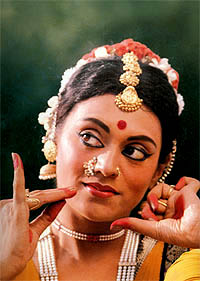 specialized in Kelika (game), Kirtana (musical performance)
and the art of transformation. In the area of Tenali Telug near the Krishna
river there is another Kuchipudi village that has its own and quite bright
dancing tradition. Two temples still stand there - Ramalingasvami and
Gopalasvami which priests are the direct descendants of either Vedantam or
Pasumarti families which are located in quite another area. The matter is that
matrimonial alliances were a common practice in old days and at some moment all
activity connected with dancing could simply relocate into the area of Tenali
Telug. specialized in Kelika (game), Kirtana (musical performance)
and the art of transformation. In the area of Tenali Telug near the Krishna
river there is another Kuchipudi village that has its own and quite bright
dancing tradition. Two temples still stand there - Ramalingasvami and
Gopalasvami which priests are the direct descendants of either Vedantam or
Pasumarti families which are located in quite another area. The matter is that
matrimonial alliances were a common practice in old days and at some moment all
activity connected with dancing could simply relocate into the area of Tenali
Telug.
The term "Kuchipudi" now applied to women dancers etymologically derived from
Potu Kuchi (literally a man dancer) and denoted simply Brahmin-dancer. Pudi is a
term applied to a village built on an embankment. There are other versions. For
instance, Sanskritists think the term "Kuchipudi" is a distortion of the word "Kuchelapuram",
the village where according to an ancient Indian epic a poor Brahman, Lord
Krishna’s friend lived.
The Bhakti movement ("devoted to God") has its most eloquent expression in the
Natya Mela tradition when dance troupes known as Vedi Natakam (street theatre)
showed musical plays based on Vayshnavi’s themes (vaishnavis are Lord Vishnu
admirers) on self-made stages. In order to recite poems an actor was required to
have erudition and a good knowledge of Sanskrit dictated by Brahmans’ authority.
This circumstance left its mark upon the whole art. Bhagavatulus in Kuchipudi
specialized not only in dance drama or Yakshagana but also in a certain kind of
opera called Kalapam.
Kalapam is a "total" theater where plots related to the same theme were closely
interwoven with the structure of musical compositions called Daru or Daruvu. For
instance, Bhama Kalapam that portrays unbelievably mobile and lively Satyabhama,
Krishna’s spouse in her different moods, is a true "corner stone" among operas.
To distinguish oneself in this part is the supreme aim of any dancer.
Another popular opera, Golla Kalapam is a dialogue between a perspicacious gopi
(a shepherdess) and a Brahman about from-the-cradle-to-the-grave philosophy of
life including mutual exchange of statements, poems and humor with metaphysical
meaning. All these operas as well as a dance drama Parijatapaharanam are
ascribed to Siddhendra Yoga a legendary Kuchipudi instructor. Nevertheless,
there are a lot of versions of these plays composed in different times by
unknown authors. There are no historical evidences to unambiguously identify
Siddhendra Yoga’s period of life; it is between XIV and XVII centuries AD. Some
researchers found a record of him even in Mellatura in Tanjor area (state
Tamilnadu) from where he supposedly migrated to Kuchipudi village. He is
described as an orphan picked up by kind neighbors. According to one of the
legends, once returning from classes in Udipi where he took a training he tried
to cross a suddenly overflowed river but got into a whirl and would not escaped
a sure death if not the Divine intervention. It was then that he made a vow to
become an ascetic singing and dancing ad gloriam Lord Vishnu who saved him from
death.
Siddhendra Yoga is ascribed a merit for Abdul Tani Shah’s presenting the
Kuchipudi village to Bhagavatulu dancers. Nevertheless, even if Siddhendra Yoga
made a great contribution to the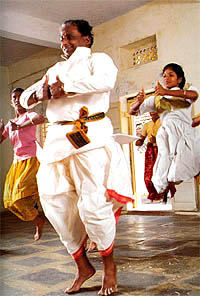 development of Kuchipudi dance which is
mentioned in an ancient manuscript Bhama Kalapam, he did not create the style.
Such predecessors of the Kuchipudi dancing tradition as Bayntavesham and
Aatavesham were popular among the Bhagavatulus. Kalapam was also performed by
devadasis (temple female dancers) as a rule in temple area. They were called
bhogamvaru or saanulu and the main theme of musical performances was the main
heroin’s appeal to her beloved. The Nayaka-nayiki (hero-heroine) theme was
closer to them then Vaishnavis’ (Lord Vishnu’s worshippers) missionary message
performed by the Bhagavatulus. development of Kuchipudi dance which is
mentioned in an ancient manuscript Bhama Kalapam, he did not create the style.
Such predecessors of the Kuchipudi dancing tradition as Bayntavesham and
Aatavesham were popular among the Bhagavatulus. Kalapam was also performed by
devadasis (temple female dancers) as a rule in temple area. They were called
bhogamvaru or saanulu and the main theme of musical performances was the main
heroin’s appeal to her beloved. The Nayaka-nayiki (hero-heroine) theme was
closer to them then Vaishnavis’ (Lord Vishnu’s worshippers) missionary message
performed by the Bhagavatulus.
Another form of performance, Yakshagana, goes back to the ancient times and is
the source of origin for Mahanatakams or main plays written by rulers of Nayaka
dynasty in Tanjor. For instance, the famous Parijatapaharanam was written and
staged by Vijayaraghava Nayaka (1633-1672). However, the Emperor Vijayanagara
Krishnadeva Raya’s court poet Mukka Timanna wrote a poem with a similar plot
much earlier.
Another great person in Kuchipudi history after Siddhendra Yoga was Narayana
Tirtha who also wrote Parijatam but this time for performers of the Bhagavata
Mela Natakam tradition from Mellatur who are a detached branch of the
Bhagavatulus from Andhra Pradesh. They migrated to Tanjor (state Tamilnadu)
after the battle at Talakota in 1565. Narayna Tirtha’s works clearly indicate
that the Bhagavatulus settled down in a Tanjor village Achyutapuram. Unlike its
double from Kuchipudi the Mela Natakam tradition was not a wandering one, but
remained strictly localized in such villages as Mellatur, Saliyamangalam,
Othukadu and Solamangalam.
The Narayana Tritha’s unusually long musical composition written in Sanskrit and
called Krishna Leela Tarangini took the first place in the Kuchipudi repertoire.
Including 153 Kirtanas (lyrical extracts of specific structure), 302 Shlokas (couplets
glorifying God), 30 Daruvus (solo parts for main heroes) and innumerable gadyas
(prose citations) his work became a peculiar landmark in literature and art.
Represented by a great number of rare melodic modulations Tarangini covered the
whole period of Lord Krishna’s both child's plays and romantic flirtations with
gopis (shepherdesses).
Daruvu or a composition of a certain specific structure used to define a
character in a play is the most important part of musical texts for Kuchipudi.
Due to such poets as Virabhadraya, Kasinathaya and Venkatarama Shastri, the
Kuchipudi repertoire started to include Natya Abhisheka Shabdam or poems
glorifying gods and kings’ deeds. As strolling artists, Kuchipudi dancers
borrowed ideas and compositions wherever they appeared. For instance, a famous
XV century actor Hari Madhavya is said to borrow a libretto from some Mellatur
plays such as Prahlada Charitam to serve as a model for his plays composed on
the same theme for Kuchipudi. But notwithstanding the fact that both Bhagavata
Mela and Kuchipudi dancers performed plays with similar plots, their
interpretations let alone dance language were completely different.
It is interesting that in Kuchipudi which is an exclusively male dancing
tradition, such female parts as
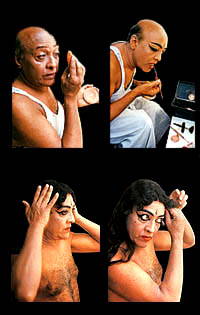 Satyabhama, Rukmini, Usha, Mohini etc. were the
most outstanding. Strivesham with its transformation into a person of opposite
sex is highly influential, and men dressed as women is the first and the most
common association that comes to mind at the mention of Kuchipudi. Such great
dancer as Vedantam Satyanarayana Sharma famous for his Satyabhama role in drama
Bhama Kalapam did not allow his " female identification" be asleep even being
engaged in such a trivial activity as regulating a microphone position before a
comment to a famous scene (lekha) from Bhama Kalapam. Satyabhama’s stage
portrait when she writes a love letter to her spouse Krishna is the most
poetical moment of the opera. Satyabhama, Rukmini, Usha, Mohini etc. were the
most outstanding. Strivesham with its transformation into a person of opposite
sex is highly influential, and men dressed as women is the first and the most
common association that comes to mind at the mention of Kuchipudi. Such great
dancer as Vedantam Satyanarayana Sharma famous for his Satyabhama role in drama
Bhama Kalapam did not allow his " female identification" be asleep even being
engaged in such a trivial activity as regulating a microphone position before a
comment to a famous scene (lekha) from Bhama Kalapam. Satyabhama’s stage
portrait when she writes a love letter to her spouse Krishna is the most
poetical moment of the opera.
An actor’s role in Kuchipudi also included the uttering of excerpts from
dialogues and even singing certain quotations. This universal mastery of a
Kuchipudi artist in singing, dancing and playing has nowadays been replaced
mostly by a "dance oriented art". A singer in a group of musicians accompanying
to a performance has taken upon himself everything concerning singing. What
concerns dialogue quotations in Telugus (the language of state Andhra Pradesh)
they have become very rare amidst urban dancers. Only in traditional Yakshagana
represented by a troupe in Kuchipudi village a text "uttering" can be heard. The
only exclusion among modern dancers is Svapnasundari who can sing, pronounce and
dance Kalapam. She thoroughly studied a solo devadasi tradition of Andhra
Pradesh, worked over the renewal of dance called Velasini Nataym together with
the now deceased Dr. Aruda a famous expert in dance.
Movements in Kuchipudi do not have common central position around which the
technique is built. A semi-sitting position with knees bent and moved apart is
used most often, but it is not the most important stylistic characteristic of
Kuchipudi as in Bharata Natyam style. But as in Bharata Natyam, the movements in
Kuchipudi are repeated from both sides of the body. There is an elegant and at
the same time elastic up-and-down movement in Kuchipudi when a dancer constantly
shifts the centre of gravity, feet contact with ground also changes constantly:
at one moment a straight leg touches the floor, at another a heel does the same,
now it is a toe, now a side surface of a foot slightly stamps on the floor.
The movement forward with toes of both feet crossed is a typical gait for
Kuchipudi executed under a certain rhythm. Kuchipudi is a very vigorous and
"jumpy" dance form. A piquant slowed down pace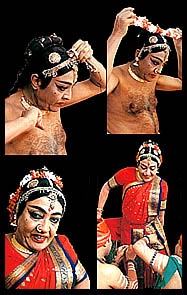 which can often be found in other
dance traditions is of rare occurrence in Kichipudi. Even abhinaya (excerpts of
meaning) does not last in an unhurried rhythm for long. The rhythm of a song and
the rhythmic pattern of lyrics are as a rule easy to remember and fill the dance
with mighty and vibrating energy. The dance-music correlations are less
structured then in other dance traditions, usually one line of a verse and music
is repeated in various rhythmic variations. For instance, in Krishna Shabdam and
Tarangam (certain dance compositions) such a repeat provides a greater
expression of dance mood, and a dancer in fact presents a whole story woven out
of pantomime and rhythm in a tala cycle (a unit of rhythm in Indian musical
system). which can often be found in other
dance traditions is of rare occurrence in Kichipudi. Even abhinaya (excerpts of
meaning) does not last in an unhurried rhythm for long. The rhythm of a song and
the rhythmic pattern of lyrics are as a rule easy to remember and fill the dance
with mighty and vibrating energy. The dance-music correlations are less
structured then in other dance traditions, usually one line of a verse and music
is repeated in various rhythmic variations. For instance, in Krishna Shabdam and
Tarangam (certain dance compositions) such a repeat provides a greater
expression of dance mood, and a dancer in fact presents a whole story woven out
of pantomime and rhythm in a tala cycle (a unit of rhythm in Indian musical
system).
A cheerful way a dancer walks into a stage and a graceful springy gait when she
leaves the stage holding a long plait decorated with flowers in her left hand
are characteristic features of Kuchipudi. When a traditional drama is performed,
the main characters are presented in the following way: two people come out into
the stage holding a curtain (tera) and a dancer hides behind it, only her plait
is visible and the spectators try to guess who there is. Only in a Bhama Kalapam
solo performance the main characters are presented in such a way.
Since there are not many records left of the ancient Kuchipudi, we only know the
names of some of the most popular dancers. They are Hari Madhavja (XV century),
brothers Chinta Venkatratnam and Chinta Ventkatramaya (1860-1949), Tadepalli
Peraya Shastri (1886-1942) and Vedantam Lakshminarayana Shastri (1875-1957).
Tadepalli Peraya Shastri is said to often act as Sutradhara (a presenter) and a
Vidhushaka (a joker) in Atta Bhagavatams, a traditional devadasi Kuchipudi
performance, thus proving there is a cooperation of two parallel traditions.
Guru Vedantam Lakshminarayana Shastri was the first to start training devadasis.
Thus, his is the merit
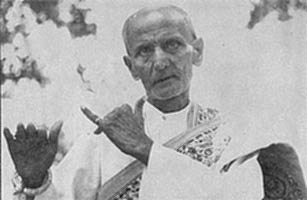 that women were again permitted to dance Kuchipudi. Solo
numbers in Kuchipudi also appeared due to Guru Vedantam Lakshminarayana Shastri.
Nowadays a solo performance in Kuchipudi contains elements not connected with
each other, some of them being independent parts from long plays. For concert
programs of single dancers all these elements (numbers) are grouped according to
the theme of the performance. that women were again permitted to dance Kuchipudi. Solo
numbers in Kuchipudi also appeared due to Guru Vedantam Lakshminarayana Shastri.
Nowadays a solo performance in Kuchipudi contains elements not connected with
each other, some of them being independent parts from long plays. For concert
programs of single dancers all these elements (numbers) are grouped according to
the theme of the performance.
The name of Guru Vedantam Lakshminarayana Shastri is known not only to Kuchipudi
dancers, among his pupils were many acknowledged dancers from other schools:
Balasarasvati, Gouri Ammal, Ram Gopal and Tara Choudhuri, all of them in their
time sought his teaching in Chennai (former Madras). He was the main guru of
Vempati Chinna Satyam who later on achieved recognition for Kuchipudi not only
in India but also all around the world. Guru Vedantam Lakshminarayana Shastri
also tought S.R. Acharyala who became a Kuchipudi teacher in Mrinalini Sarabhai
Academy in Ahmedabad. Nataraj Ramakrishna who renewed several old devadasi dance
traditions such as Janardhana Parijatam belonging to Andhra Natyam tradition,
also studied at Lakshminarayana Shastri. His outstanding contribution to the
preserving of the Kuchipudi cultural tradition was highly appraised and he was
awarded with Simhatalamu (a chased golden bracelet) when he was 68 years old
already. The eminent cultural workers of Chennai gave him the Balagopala
Tarangama performed by a female dancer Samrajama as a present. In its time
Tarangam for the first time staged by Guru Vedantam Lakshminarayana Shastri
surprised spectators. This dance is a measure of high level of mastery for a
Kuchipudu dancer because it is executed on the edges of a brass plate while
beating complex and tangled rhythm with feet.
In spite of the fact that such Gurus as Chinta Narayanamurti, Yelesvarupa
Narayanappa, Vedantam Raghvaya, Chinta Venkatramaya and Lakshminarayana Shastri
were experts in Strivesham (the art of performing female roles), starting 1950s
female dancers began firmly taking their place in the Kuchipudi tradition. In
his article on Guru Lakshminarayana Shastri’s award, Mohan Khokar wrote that the
Minister of Finance of India B. Goppala Reddi said in his speech that Kuchipudi
would have no future if women were not allowed to dance performance.
The caste barrier was also broken. In Nuzvida, S.R. Acharyala trained Korada
Narasimha Rao who did not belong to traditional Kuchipudi families. Korada
Narasimha Rao who later studied at great guru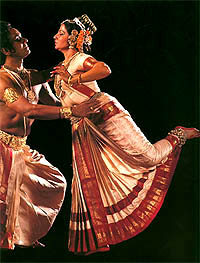 Lakshminarayana Shastri became
famous for his bright and convincing performance of demon Bhasmasura. Besides,
Korada was the first partner of the acknowledged Bharata Natyam female dancer
Indrani Rehman. This duo marked the beginning of the "pair" trend in Kuchipudi
which is still popular today. The examples of such pairs are such famous dancers
as Radja and Radha Reddi, Narasimhachari and Vasantha Lakshmi, Vanashri and
Jarayama Rao and many other tandava-lasya duos which participants are not
necessary married. Lakshminarayana Shastri became
famous for his bright and convincing performance of demon Bhasmasura. Besides,
Korada was the first partner of the acknowledged Bharata Natyam female dancer
Indrani Rehman. This duo marked the beginning of the "pair" trend in Kuchipudi
which is still popular today. The examples of such pairs are such famous dancers
as Radja and Radha Reddi, Narasimhachari and Vasantha Lakshmi, Vanashri and
Jarayama Rao and many other tandava-lasya duos which participants are not
necessary married.
For the first time in 1955 two female dancers Mohana and Samanti presented two
numbers in the Kuchipudi style at the National Dance Festival in Sangit Natak
Academy in Mumbai (former Bombay). At that time Kuchipudi was not acknowledged
as a true classic dance tradition that’s why their numbers were announced as
"Kuchipudi-Bharata Natyam" compositions. Even in 1958 at Sangit Natal Academy
Festival there still was not a special place for Kuchipudi and the only
Kuchipudi dancer was Kanchamala who demonstrated a small fragment of dance. Only
in 1959 The Music Academy in Andhra Pradesh with support from Bandhi
Kanakalingeshvara Rao, Ayanka Tandava, Lanka Suryanarana Shastri and Ramakottai
organized a seminar in support of the idea to recognize Kuchipudi as an
independent dance form equally with other classic styles of dance. This resulted
in the opening of Siddhendra Kalakshetra Kuchipudi’s branches in Elluru and
Gudivat. Yakshagana named "Abhijnana Shakuntalam" presented at the seminar by
Sampatkumar and Kumar Sambhavam convinced such connoisseurs of dance as E.
Krishna Iyer, Damayanti Josti and Nayna Jhaveri that Kuchipudi quite deserved to
be considered a classic dance tradition.
Later the famous Raja and Radha Reddi who by the way did not belong among the
traditional
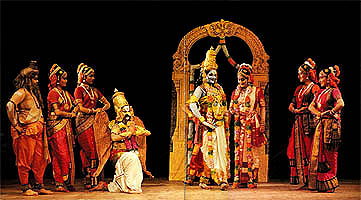 Kuchipudi families either, founded several quite prosperous dance
schools. The great Yamini Krishnamurti demonstrated the art of Kuchipudi almost
in every corner of the world by virtuosic performing Bhama Kalapam and Krishna
Shabdam. Her teacher Guru Chinta Krishnamurti said not without pride that
Kuchipudi had seen its new "star" hour thanks to Yamini. As a result of all
these events the village of Kuchipudi proved not to be able to accommodate the
dance tradition that acquired new perspectives, that’s why many teachers fixed
their eyes on Chinnai, the cultural capital of India and the place of
flourishing of the film industry. Dancers were mostly women then. They paced
proudly with moustaches on portraying typical male characters of Yakshagana:
demons Hiranyakashipa, Jarasandhi, Bali and even Bhasmasura everywhere besides
village Kuchipudi. But the city demanded new roles and spectators saw the images
of Divine Rama, Krishna and Shrinivasa performed in a soft and delicate way due
to the new interpretation by female dancers. Thus Kuchipudi has drawn a full
circle in its development. Kuchipudi families either, founded several quite prosperous dance
schools. The great Yamini Krishnamurti demonstrated the art of Kuchipudi almost
in every corner of the world by virtuosic performing Bhama Kalapam and Krishna
Shabdam. Her teacher Guru Chinta Krishnamurti said not without pride that
Kuchipudi had seen its new "star" hour thanks to Yamini. As a result of all
these events the village of Kuchipudi proved not to be able to accommodate the
dance tradition that acquired new perspectives, that’s why many teachers fixed
their eyes on Chinnai, the cultural capital of India and the place of
flourishing of the film industry. Dancers were mostly women then. They paced
proudly with moustaches on portraying typical male characters of Yakshagana:
demons Hiranyakashipa, Jarasandhi, Bali and even Bhasmasura everywhere besides
village Kuchipudi. But the city demanded new roles and spectators saw the images
of Divine Rama, Krishna and Shrinivasa performed in a soft and delicate way due
to the new interpretation by female dancers. Thus Kuchipudi has drawn a full
circle in its development.
Today men playing female parts are very rare. Even such Kuchipudi veteran as
Vedantam Satyanarayana prefers demonstrating strivesham in usual male clothes
limiting him with the make-up necessary for the role. Vedantam Venkatachalapati,
the son of the deceased Guru Vedantam Rattaya Sharma, while playing male and
female parts allowed himself a wider scope for creative self-realization than
his uncle Satyanarayana Sharma who specialized exclusively on female parts. Only
Pasumarthi and Yelesvarupa Shrinisvan still dance exclusively female parts, but
today there are so many female Kuchipudi dancers that necessity for men to take
on woman appearance has almost fallen away. In spite of the fact that the most
part of traditional Kuchipudi training takes place in towns, Siddhendra
Kalakshetra located in Kuchipudi village still works and the process of study
there requires greater efforts of teachers and students.
The appearance of a more sophisticated version of dance in the Kuchipudi
tradition owes a debt to Guru Vempati Chinna Satyam and his Kuchipudi Art
Academy in Chennai within the walls of which the most part of modern dancers of
this style "grew up". Many of the Kuchipudi Art Academy graduates later on
founded their own schools in India as well as abroad, for instance: Shobha Naidu,
Ratna Kumar, Kamala Reddi, Sasikala, Kalpalatika, Anuradha Neru, Anuradha
Jonnalageda, Manju Bhargavi and Guru Vempatti Chinna Satyama’s son Vempati Ravi. most part of modern dancers of
this style "grew up". Many of the Kuchipudi Art Academy graduates later on
founded their own schools in India as well as abroad, for instance: Shobha Naidu,
Ratna Kumar, Kamala Reddi, Sasikala, Kalpalatika, Anuradha Neru, Anuradha
Jonnalageda, Manju Bhargavi and Guru Vempatti Chinna Satyama’s son Vempati Ravi.
The result of close cooperation of several years' standing among Vempati Chinna
Satyam and poet Bhujanga Sharma and composer P. Sangita Rao was the staging of a
great number of dance dramas first in India and then abroad. Thus, Guru Vempati
Chinna Sayam holds the merit of spreading the Kuchipudi dancing tradition all
over the world.
Vempati was an innovator in everything. He unconditionally supported female
dancers playing male parts, because he felt that men playing female parts had
lost its actuality. For the first time in the Kuchipudi history he started to
use such beautiful ragas (musical compositions) as Mohan, Muhari, Bhayaravi and
Kamboji and also some ragas not belonging to Karnatik tradition as a musical
accompaniment to his dance dramas. Besides he brought many elements of the
technique to perfection due to which the complexity of their executing has
increased. It was Guru Vempati who insisted on using vachika-abhinaya in dance (synchronization
of a dancer’s lips with lyrics), which is a characteristic feature of Kuchipudi
today and distinguishes it from other classic dance forms. If before Vempati
Chinna Satyam satvika-abhinaya was mostly used when a dancer had to take full
possession of his emotions and express them in minimal but rather intensive
motions, then due to Vempati it became possible to use angika-abhinaya when all
body serves for expressing emotions.
Many experts in the field of the art of dance still treat Vempati Chinna
Satyam’s phenomenon ambiguously, ones honour him beyond all measure and the
others on the contrary criticize him. But nevertheless, everyone recognizes that
without him Kuchipudi would not exist in the form it is known today.
| 